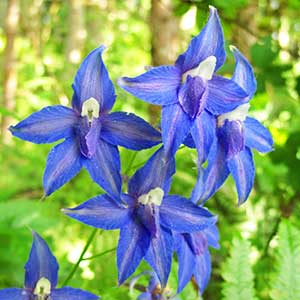Delphinium trolliifolium
Delphinium stachydeum
Columbian larkspur, cow-poison, poison delphinium, poison larkspur
hedgenettle larkspur, Rocky Mountain larkspur, spike larkspur, Umatilla larkspur
(40-)60-120(-180) cm;
base usually reddish, glabrous to puberulent.
(40-)70-150(-200) cm;
base reddish, puberulent.
blade ± pentagonal, 4-8 × 7-16 cm, margins ± incised, nearly glabrous; ultimate lobes 0-9, width 15-30 mm (basal), 5-20 mm (cauline), widest at middle or in proximal 1/2.
blade light green, ± round, 2-8 × 3.5-11 cm, sparsely pubescent; ultimate lobes 7-19, width 1-8 mm, apex tapering to point;
veins obscure.
(5-)14-40(-75)-flowered, ± open, at least 2 times longer than wide;
pedicel 1-4(-9) cm, puberulent to glabrous;
bracteoles (2-)6-12 mm from flowers, green, linear, 5-9(-14) mm, puberulent.
(14-)30-60(-102)-flowered, dense, cylindric;
pedicel spreading, 0.8-2(-3) cm, puberulent;
bracteoles 1-4 mm from flowers, green, linear, 2-7(-10) mm, puberulent.
sepals dark blue, glabrous, lateral sepals spreading, (8-)14-21 × 5-9 mm, spurs straight or downcurved at apex, within 20° of horizontal, (10-)16-23 mm;
lower petal blades covering stamens, 5-10 mm, clefts 1.5-3 mm;
hairs sparse, mostly near junction of blade and claw, centered or on inner lobes, well dispersed, yellow.
sepals bright blue, puberulent, lateral sepals spreading, 9-13 × 4-7 mm, spurs straight, within 30° above or below horizontal, 11-17 mm;
lower petal blades ± covering stamens, 4-8 mm, clefts 0.5-2 mm;
hairs sparse, centered, mostly near junction of blade and claw above base of cleft, white.
(15-)23-34 mm, 3.8-5.5 times longer than wide, glabrous.
10-15 mm, 3.5-4.5 times longer than wide, puberulent.
unwinged;
seed coats smooth.
wing-margined;
seed coat cells with margins straight, surfaces ± roughened.
= 16.
Delphinium trolliifolium
Delphinium stachydeum
Delphinium trolliifolium occurs in the northern Coast Range of California, the Columbia River Valley to just east of Mt. Hood, and the Willamette Valley of Oregon upstream to Lane County. California plants differ somewhat from Oregon plants in pubescence patterns and habitat preferences. Further study may show that two entities are involved here.
Hybrids between Delphinium trolliifolium and D. decorum, D. menziesii subsp. pallidum (D. ×pavonaceum Ewan, Peacock larkspur), D. nudicaule, D. nuttallianum, and D. nuttallii are known. Delphinium trolliifolium is likely to be confused only with D. bakeri. Refer to discussion under that species for differences.
(Discussion copyrighted by Flora of North America; reprinted with permission.)
Populations of Delphinium stachydeum are widely scattered in isolated mountain ranges surrounded by desert or grassland. The species has been reported (visual sightings) from northwestern Utah; no specimens have been seen from there. Hybrids between D. stachydeum and D. glaucum have been reported. Although D. stachydeum has been seen flowering within 30 m of flowering D. depauperatum, no hybrids have been observed.
Delphinium stachydeum may possibly be confused with D. geyeri, from which it may be distinguished by its usually greater plant size, less pubescent foliage, and later flowering date. Delphinium stachydeum also may be confused with D. glaucum; see discussion under that species.
(Discussion copyrighted by Flora of North America; reprinted with permission.)
- Local floras:
CA,
OR,
WA
- Local Web sites:
CalFlora,
CalPhotos,
Flora NW,
PNW Herbaria
WildflowerSearch
iNaturalist (observations)
USDA Plants Database
- LBJ Wildflower Center
- SEINet
- Plants of the World Online
- Encyclopedia of Life
- Wikipedia
- Google Image Search


